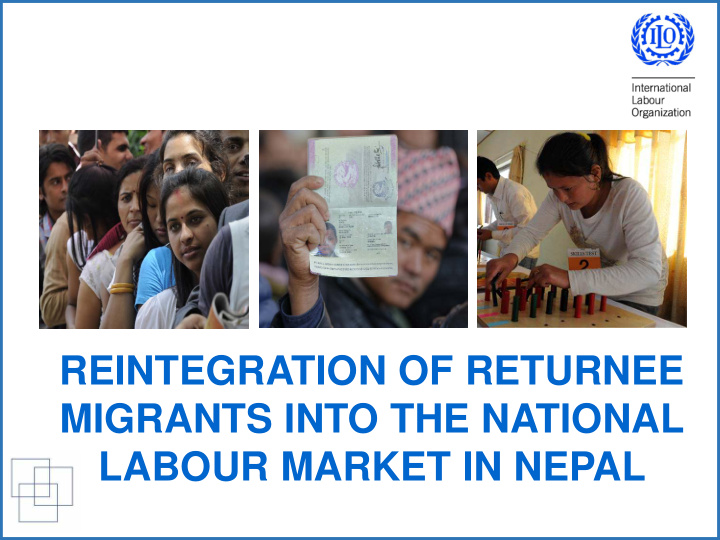



REINTEGRATION OF RETURNEE MIGRANTS INTO THE NATIONAL LABOUR MARKET IN NEPAL
CONTEXT • Close to half a million labour permits issued in last fiscal year • Majority of migrant workers between the age of 15 to 29 years of age • While 36.5% of migrants have at least secondary level education, 22% only have primary education • Skills categorization of Nepali migrant workers 73.67% as “unskilled” 11.96% as semi-skilled 14.34% as skilled 0.02% as professional
OBJECTIVES • To explore transferability of skills and experience of returnee migrant workers in the national labour market: Review the existing policy and programmatic frameworks to support the reintegration of returnee migrants in the labour market Analyse the existing challenges and opportunities to recognize the skills of returnee migrant workers
METHODOLOGY Secondary research using datasets and researches • conducted to analyse the research propositions Qualitative research methodology • Policy and programmatic review Key informant interviews and stakeholder discussions Purposeful sampling of returnee migrant workers to carry out in-depth interviews
LAWS AND POLICIES ON RETURNEE MIGRANTS • Fourteenth National Development Plan (2015/16–2017/18): Provision on trainings and counselling for self-employment and entrepreneurship Social mobilization to utilize skill and capacity of returnee migrants as part of their reintegration • Foreign Employment Policy 2012: Effective social and economic reintegration packages with stress on productive investment Utilization of returnees as trainers for orientations and skills training • Foreign Employment Act 2007: Employment-oriented programs for returnee migrants workers
SKILLS TESTING • Skills testing initiated in 1983 and being conducted by the National Skills Testing Board • Based on corresponding 284 occupational skills standards Missing link with occupations of migrant workers • 81 skills testing centers located in 51 districts • Requirements for skill test participation Citizenship card, age 16 and above Letter from either VDC/municipality or government registered private firm or trade union
FOCUS ON THE CONSTRUCTION SECTOR • Post Disaster Needs Assessment after the earthquake in 2015 pointed out huge requirement of labour for reconstruction Estimated 700,000 workers needed for reconstruction 46% of the labour force required has to be skilled • Expected to grow by 11.7% in the current fiscal year • Share of contribution to GDP expected to be at 7.2% • Prevalence of employing labour through subcontractors
KEY REFLECTIONS • Awareness Lack of information about skills testing Lack on awareness that skills gained through informal setting can be formally recognized • Accessibility Cost of the process Prerequisites of getting tested • Demand for skills recognition Limited recognition by employers • Informality of the sector Limited job matching Recruitment of workers
KEY REFLECTIONS • Perception towards returnee migrants No differentiation in skills of returnee migrants Challenges in retaining returnee migrants • Mobility within the hierarchy of workers Returnee migrants found to be more mobile • Labour market information No demand data from employers • Impact of skills recognition Limited understanding of the impact on various levels
Thank you! Niyama Rai ILO Country Office for Nepal E-mail: niyama@ilo.org
Recommend
More recommend